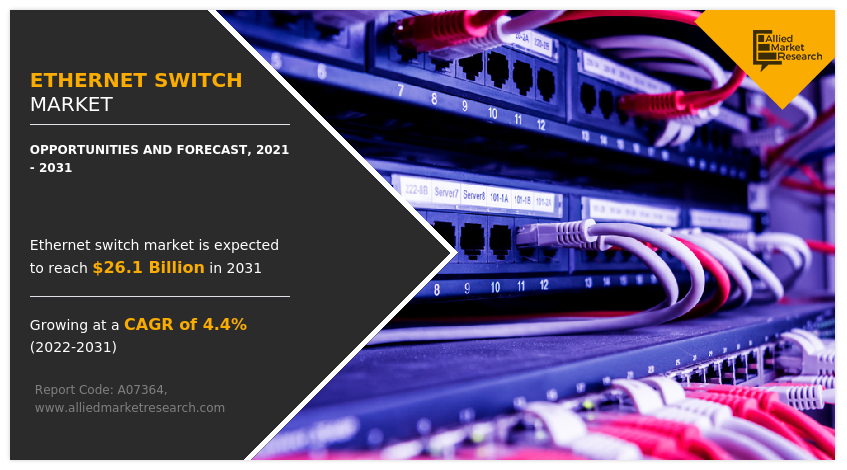Ethernet Switch Market Overview:
According to the research report published by Allied Market Research, the global ethernet switch market was estimated at $17.2 billion in 2021 and is projected to reach $26.1 billion by 2031, exhibiting a compound annual growth rate (CAGR) of 4.4% from 2022 to 2031.
The key market factors propelling the market growth are the growing number of end-users and the ethernet switch. The research study offers information on market size and share study, market dynamics, segmental and regional analysis, and competitive landscape for the forecast period 2021 to 2031, providing essential a comprehensive idea of the entire market environment.
Download Research Sample: https://www.alliedmarketresearch.com/request-sample/7729
Ethernet Switch Market Trends:
1. Increasing Demand for High-speed Connectivity: With the growing adoption of bandwidth-intensive applications and the proliferation of connected devices, there is a rising demand for high-speed Ethernet switches. Businesses need faster and more reliable networks to support data-intensive activities, driving the growth of high-speed Ethernet switches.
2. Transition to Gigabit Ethernet: The market is witnessing a shift from Fast Ethernet to Gigabit Ethernet switches. The need for faster data transfer rates and improved network performance is pushing organizations to upgrade their networks with Gigabit Ethernet switches. This transition is particularly prominent in industries such as data centers, enterprise networks, and cloud computing.
3. Rise of Power over Ethernet (PoE): Power over Ethernet technology has gained significant traction in recent years. PoE allows the transmission of power and data over a single Ethernet cable, eliminating the need for separate power cables. The increasing adoption of PoE-enabled devices, such as IP cameras, wireless access points, and VoIP phones, is driving the demand for PoE switches in various sectors, including security, healthcare, and retail.
4. Growing Network Virtualization and Software-defined Networking (SDN): Network virtualization and SDN technologies are transforming the networking landscape. These technologies enable centralized management, improved agility, and flexibility in network configurations. Ethernet switches that support SDN, and network virtualization are in high demand as organizations seek to optimize their network infrastructure and adapt to changing business requirements.
5. Increasing Adoption of Cloud Services: The rapid growth of cloud computing and the migration of applications and data to the cloud are driving the need for robust and scalable network infrastructure. Ethernet switches with advanced features like high scalability, low latency, and high throughput are essential for building reliable and efficient cloud networks.
6. Focus on Network Security: With the rise in cyber threats and data breaches, network security has become a top priority for organizations. Ethernet switches with built-in security features, such as access control lists (ACLs), port security, and secure management interfaces, are in high demand. Additionally, the integration of security features like deep packet inspection (DPI) and threat intelligence enhances network security and drives market growth.
7. Embracing the Internet of Things (IoT): The proliferation of IoT devices is creating new demands for network infrastructure. Ethernet switches that can handle the increased device connectivity and data traffic generated by IoT devices are essential. The ability to support IoT protocols, such as MQTT and CoAP, and provide sufficient Power over Ethernet capabilities are key factors driving the Ethernet switch market.
8. Green Ethernet and Energy Efficiency: Energy efficiency has become a critical consideration for organizations aiming to reduce their carbon footprint and operating costs. Green Ethernet switches, which optimize power consumption based on network traffic and device activity, are gaining popularity. Energy-efficient Ethernet (EEE) standards, such as IEEE 802.3az, are being implemented in switches to reduce power consumption during periods of low network activity.
9. Integration of Artificial Intelligence and Machine Learning: The integration of AI and ML technologies into Ethernet switches is enabling intelligent network management, self-healing capabilities, and advanced analytics. AI-powered switches can automatically detect and mitigate network issues, optimize network performance, and provide valuable insights for network administrators.
Interested to Procure the Data? Inquire Here: https://www.alliedmarketresearch.com/purchase-enquiry/7729
Ethernet Switch Market Segmentation:
The ethernet switch market is segmented based on type, configuration, speed, and region.
Ethernet Switch Market, By Type:
- Fixed Configuration Ethernet Switches
- Modular Ethernet Switches
Ethernet Switch Market, By Configuration:
- Unmanaged
- Divided
- Smart
- Managed L2
- Managed L3
Ethernet Switch Market, By Speed:
1G, 10 G, 25 G, 40 G, 100 G, and Others.
Ethernet Switch Market, By Region:
- North America
- Europe
- Asia-Pacific
- LAMEA
Key Questions Covered in the Ethernet Switch Market Report:
- What factors are estimated to drive and restrain market growth?
- What are the key technological and market trends shaping the market?
- What are the key companies operating in the market?
- What is the market size or growth rate of the ethernet switch market?
More Insights:
Ethernet PHYs Market: https://www.alliedmarketresearch.com/ethernet-phys-market-A14812
Ethernet Connector Market: https://www.alliedmarketresearch.com/ethernet-connector-market-A15150
Ethernet Controller Market: https://www.alliedmarketresearch.com/ethernet-controller-market-A15151
Ethernet Server Adaptor Market: https://www.alliedmarketresearch.com/ethernet-server-adaptor-market-A15649
Ethernet Cable Market: https://www.alliedmarketresearch.com/ethernet-cable-market
